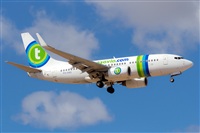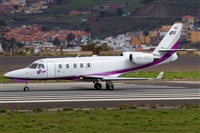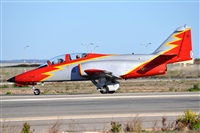 |
|
757
views |
|
|
|
|
|
|
|
|
|
|
|
|
|
|
|
|
|
|
Remarks |
|
|
EL primer King Air 350 recibido recientemente por la Marina Armada de Mexico
|
|
|
|
|
|
|
|
 |
|
1006
views |
|
|
|
|
 |
|
965
views |
|
|
|
|
 |
|
880
views |
|
|
|
|
|
|
|
|
|
|
|
|
|
|
|
|
|
|
Remarks |
|
On 6th April 1965, the day of her maiden flight, the UK Labour Government terminated the project. Whitehall were doubtless aware that XR220 was due to fly that day and ministers were conscious that a successful flight would make it even more difficult to justify the cancellation of the TSR-2.
Over specified.....over budget....but still looking awesome some 50 years later !
|
|
|
|
|
|
|
|
|
|
|
|
|
|
|
|
|
|
|
|
|
|
Remarks |
|
|
One of 70 Pucara reconnaissance and counter insurgency attack aircraft delivered to Argentine Air Force (Fuerza Aerea Argentina) by early 1982 as A-515, one of 35 Pucaras allotted to Grupo 3 de Ataque (III Brigada Aerea). Allocated RAF serial ZD485
|
|
|
|
|
|
|
|
|
|
|
|
|
|
|
|
|
|
|
|
|
|
Remarks |
|
|
In 1924, the Royal Aero Club organized a Light Aircraft Competition. £3000 was offered in prizes. An entry was made by Hawker Aircraft, which was a design by Sydney Camm, the Cygnet. Camm had joined Hawker the previous year. Two aircraft were built (G-EBMB and G-EBJH) and were entered in the competition, held in 1924 at Lympne Aerodrome, by T. O. M. Sopwith and Fred Sigrist. The aircraft were flown by Longton and Raynham and came in 4th and 3rd places respectively. In 1925, G-EBMB was entered again in the 100 mi (161 km) International Handicap Race, this time flown by George Bulman, who won at a speed of 75.6 mph (121.7 km/h). At the same meeting, the Cygnet came 2nd in the 50 mi (80 km) Light Aeroplane Race. In 1926, both aircraft were entered in the competition piloted by Bulman and Flying Officer Ragg, taking first and second place respectively.
|
|
|
|
|
|
|
|
|
|
|
|
|
|
|
|
|
|
|
|
|
|
Remarks |
|
1st of type on AC !
30 Sea Balliols were produced and served with 781 squadron at Lee-on-Solent and 1843 Squadron RNVR at Abbotsinch. The last one was delivered in December 1954
The Merlin powered Balliol, designated Balliol T.2, first flew on 10 July 1948 and after extensive evaluation, it was chosen over the Athena, with large orders being placed to replace some of the Harvards in RAF service.
The Sea Balliol T.21 had folding wings and arrestor hook for deck landings.
By 1951, however, the Air Ministry changed its mind about its training requirements yet again and decided to introduce a jet-powered advanced trainer, the de Havilland Vampire T.Mk11.
|
|
|
|
|
|
|
|
|
|
|
|
|
|
|
|
|
|
|
|
|
|
Remarks |
|
|
Built by British Aerospace as the sole example of the Experimental Aircraft Programme technology demonstrator, as part of the development of a new agile air superiority fighter, which eventually appeared as the Eurofighter Typhoon. In May 1983, the British Government signed a contract with BAe for EAP development. This was jointly funded by the Ministry of Defence and industry including MBB of Germany and Aeritalia. The single airframe was intended to research technologies associated with advanced fighter development, incorporating a fly-by-wire system (evaluated on Jaguar test bed XX765), and the concept of the delta wing with canards. The airframe was built by BAe using an adapted Tornado rear fuselage and fin/rudder and one Italian built wing. First flight 8 August 1986
|
|
|
|
|
|
|
|
|
|
|
|
|
|
|
|
|
|
|
|
|
|
Remarks |
|
As the final ‘Aardvark’ production variant, the F-111F featured improved avionics, including navigational and digital computer systems, improved wing structure and landing gear, and more powerful Pratt & Whitney TF30-P-100 engines; 106 were built.
|
|
|
|
|
|
|
|
|
|
|
|
|
|
|
|
|
|
|
|
|
|
Remarks |
|
Surrendered to elements of
Surrendered to the RAF Regiment at Husum airfield, Schleswig - Holstein, close to the Danish border. By late April 1945 Husum had become the base of the last operational Me163 Unit, II/JG400 with some 80 Me163B aircraft on strength, largely grounded due to lack of fuel.
|
|
|
|
|
|
|
|
|
|
|
|
|
|
|
|
|
|
|
|
|
|
Remarks |
|
The Bristol 188 was the first Bristol turbojet aeroplane to be built. Two flying examples were constructed with the objective of reaching and sustaining twice the speed of sound for long enough to enable steady-state kinetic heating effects on the structure to be experienced and recorded.
After considerable production delays the first aircraft XF923, made its maiden flight 14 April 1962. First flight of XF926,from Filton ,was 29 April 1963.
Both aircraft were grounded indefinitely and the project suspended in February 1964, partly due to problems of high fuel consumption and the inability to reach sustained high speed and achieving the original operational requirement for the project.
|
|
|
|
|
|
|
|
|
|
|
|
|
|
|
|
|
|
|
|
|
|
Remarks |
|
|
To the RAF Museum Cosford December 2012 after many years suspended in the Imperial War Museum, London
|
|
|
|
|
|
|
|
 |
|
1117
views |
|
|
|
|
|
|
|
|
|
|
|
|
|
|
|
|
|
|
Remarks |
|
|
Hoy le tocaba a un "Asia" cubrir la ruta.
|
|
|
|
|
|
|
|
|

